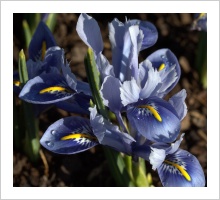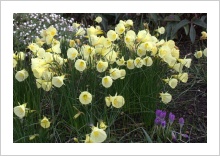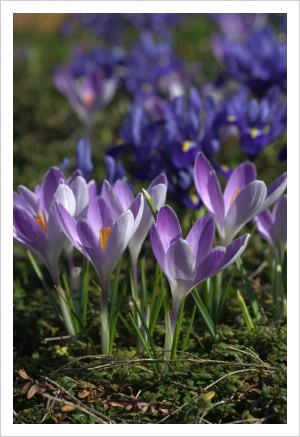Garden Harmony
Words can hardly describe how beautiful two parts of the garden are at the moment. (They’ll be even more beautiful this weekend, the 15th and 16th August) Five years ago I planted a few dozen bulbs of Iris ‘Harmony’ in a garden bed near the car park. The increase has been so prodigious that this  year there are many hundreds of perfectly formed blue irises perched on strong 15cm tall stems. The flowers are unbothered by the wet, frosty and windy weather we’ve had over the past week or so.
year there are many hundreds of perfectly formed blue irises perched on strong 15cm tall stems. The flowers are unbothered by the wet, frosty and windy weather we’ve had over the past week or so.
‘Harmony’ is a hybrid between two species native to Turkish mountains where they flower almost as soon as the snow melts. Iris reticulata is native to the mountains of eastern Turkey, western Iran, northern Iraq and the Caucasus. Iris histrioides is more localised in distribution only being found in a small area in northern Anatolya. Iris histrioides ‘Lady Beatrix Stanley’, which is a reasonably good doer in my garden, is very close to some of the wild forms. The flowers are mid-blue with paler flecking on the falls surrounding a gold stripe. On warm days it has a delicious violet fragrance.
Iris ‘Harmony’ has inherited the beauty of both its parents with the added advantage of hybrid vigour. ‘Alida’ is a paler blue sport of ‘Harmony’ and it too is in flower.
 |
 |
 |
| Iris reticulata 'Harmony' | Iris reticulata 'Alida' | Iris reticulata 'Lady Beatrix Stanley' |
All of these Iris are easy to grow as long as their few wants are catered for. They do need a spot in the garden that is allowed to dry out during summer. If the soil is too acidic i.e. with a Ph below 5.5 then a good handful of dolomite or ground limestone per square metre would be beneficial. I plant the bulbs 12-15 cm deep. Iris reticulate and I. histrioides are unhappy when grown in pots as they will go into decline, although good sized bulbs will flower in pots the first year. After that it’s best to plant them out into the open garden.
 Narcissus ‘Spoirot’ is a free flowering and rapidly increasing moon-light wan hoop petticoat daffodil. One of its parents, N. cantabricus, calls the hot dry hills and mountains of Spain and Morocco home so our climate suits it very well. It has made large flowering clumps which contrast nicely with the Iris.
Narcissus ‘Spoirot’ is a free flowering and rapidly increasing moon-light wan hoop petticoat daffodil. One of its parents, N. cantabricus, calls the hot dry hills and mountains of Spain and Morocco home so our climate suits it very well. It has made large flowering clumps which contrast nicely with the Iris.
 Crocus vernus ‘Vanguard’ is also at its best this week. The clone that the Dutch bulb companies are selling is nowhere near as beautiful as a clone I was given forty years ago by Otto Fauser, the great Australian bulb maestro. I still have a few of the old selection and hope to have enough soon to plant out a decent patch.
Crocus vernus ‘Vanguard’ is also at its best this week. The clone that the Dutch bulb companies are selling is nowhere near as beautiful as a clone I was given forty years ago by Otto Fauser, the great Australian bulb maestro. I still have a few of the old selection and hope to have enough soon to plant out a decent patch.
Talking about Crocus vernus, the mass planting of the large Dutch selections of this European mountain bulb will be at its best over the next ten days or so. Growing on both sides of a grass path flanked by Pyrus calleryana ‘Valiant’ the display gets better every year.
These bulbs have been selected and reselected by Dutch bulb growers for the best part of four hundred years and modern varieties are nearly as big as tulips. En masse they make a breath taking display.
This bed is watered at the most once during the summer.